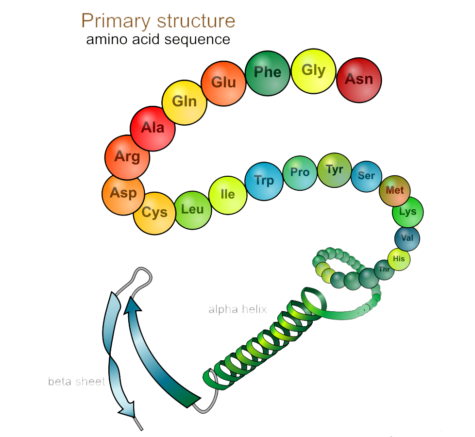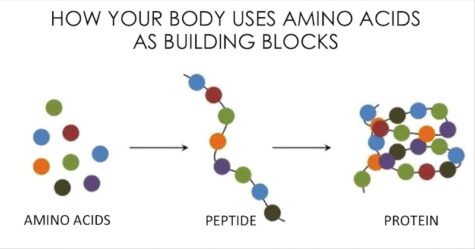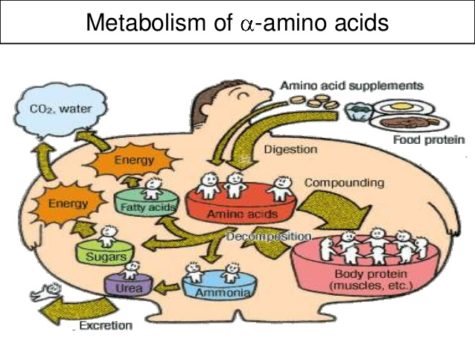The Amazing Power of Amino Acids
 In 1838, a Dutch chemist, G.J. Mulder, described a certain organic material as “unquestionably the most important of all known substances in the organic kingdom. Without it, no life appears possible on our planet. Through its means the chief phenomena of life are produced. ” This complex nitrogen-bearing substance was called protein from the Greek word meaning ” take the first place.”
In 1838, a Dutch chemist, G.J. Mulder, described a certain organic material as “unquestionably the most important of all known substances in the organic kingdom. Without it, no life appears possible on our planet. Through its means the chief phenomena of life are produced. ” This complex nitrogen-bearing substance was called protein from the Greek word meaning ” take the first place.”
Protein is now a group name signifying the principal nitrogenous constituents of the protoplasm of all plant and animal tissues. Proteins are extremely complex organic compounds of the elements carbon, hydrogen, oxygen, nitrogen, and,with some exceptions, sulfur. Most proteins also contain phosphorous, and some specialized proteins contain iron, iodine, copper and other inorganic elements.
The presence of nitrogen distinguishes proteins from carbohydrates and fats. Proteins are thus vital substances, which form important constituent of muscles, tissues, and the blood. Proteins supply the building material for the body and make good the wear and tear of tissues. Several substances concerned with vital life processes such as enzymes, which help in digestion of food, are chiefly protein in nature.
There are several varieties of protein. Each type contains a specific number of “building blocks ” known as amino-acids. Before they can be absorbed by the body, all proteins must first be broken down into amino-acids. When food stuffs are ingested, the nutrients and amino-acids do not immediately diffuse into all the different tissues. There are a series of biochemical reactions in the digestive tract which collect these proteins, break them down and then utilize them as needed. Any interference with the normal digestive process causes in-complete protein digestion resulting in gas, bloating etc.
There are about 22 amino acids needed for the normal functioning of the body. The body can manufacture many amino acids if it has no adequate nitrogen source, but it cannot produce certain others in sufficient amounts to meet its needs. The amino acids that the body cannot synthesize in adequate amounts are called essential or indispensable because they must be supplied by the diet in proper proportions and amounts to meet the requirements for maintenance of growth. Non-essential or dispensable amino acids are those that the body can synthesize in sufficient amounts to meet its needs if the total amount of nitrogen supplied by protein is adequate.
Classification of Amino Acids with respect to their essentiality:
Essential Amino Acids
- Histidine*
- Isoleucine
- Leucine
- Lysine
- Methionine
- Phenylalanine
- Theronine
- Trypophan
- Valine
- Hydroxyproline
- Proline
- Serine
- Tyrosine
*Histidine is required for infants but its essentiality for adults has not been clearly established.
Nonessential Amino Acids
- Alanine
- Arginine
- Asparagine
- Aspartic acid
- Cysteine
- Cystine
- Glutamic acid
- Glutamine
- Glycine
It will be seen from this statement that nine amino acids are essential for maintenance of nitrogen equilibrium in human bodies. The estimated requirements of essential amino acids for infants, children and adults are given below. Men in the older age group appear to differ in their requirements. Studies seem to suggest an increase need for methionine and lysine for them. Infants and children have proportionally greater demands for essential amino acids than adults. In addition, infants require histidine as an essential amino acid.
Daily Requirements:
Estimating the daily requirement for the indispensable amino acids has proven to be difficult; these numbers have undergone considerable revision over the last 20 years. The following table lists the WHO and United States recommended daily amounts currently in use for essential amino acids in adult humans, together with their standard one-letter abbreviations.
| Amino acid(s) | WHO mg per kg body weight | WHO mg per 70 kg | US mg per kg body weight |
|---|---|---|---|
| H Histidine | 10 | 700 | 14 |
| I Isoleucine | 20 | 1400 | 19 |
| L Leucine | 39 | 2730 | 42 |
| K Lysine | 30 | 2100 | 38 |
| M Methionine+ C Cysteine | 10.4 + 4.1 (15 total) | 1050 total | 19 total |
| F Phenylalanine+ Y Tyrosine | 25 (total) | 1750 total | 33 total |
| T Threonine | 15 | 1050 | 20 |
| W Tryptophan | 4 | 280 | 5 |
| V Valine | 26 | 1820 | 24 |
The recommended daily intakes for children aged three years and older is 10% to 20% higher than adult levels and those for infants can be as much as 150% higher in the first year of life. Cysteine (or sulfur-containing amino acids), tyrosine (or aromatic amino acids), and arginine are always required by infants and growing children.
Factors in addition to the age, sex and physiological condition of an individual influence the requirements for specific amino acids. If total protein intake is low, small surpluses of certain amino acids can increase the need for others.
The non-essential amino acids in protein also affect the quality of protein. For example, the amount of sulphur – containing essential amino acid methionine required may be somewhat reduced if cystine, a sulfur-containing nonessential amino acid,is supplied in the diet. Likewise, the presence in the diet of tyrosine, a non-essential amino acid similar in structure to phenylalanine, may reduce the requirement for phenylalanine.
Much research has been done on amino acids in recent times and this has paved the way for dramatic treatment and cure of different problems by their judicious use. They are now dubbed as ” the nutrients of the 80’s” and “medical foods”.
The various functions of the essential and frequently investigated non-essential amino acids, their deficiency symptoms and their therapeutic uses are discussed below :
Tryptophan
Of all the essential amino acids , tryptophan is the one that is most investigated by nutrition researchers. It is essential to blood clotting, digestive juices and the optic system. It induces sleep and quietens the nervous system. It wards off signs of premature old age – cataracts of the eyes, baldness, deterioration of sex glands and malformation of teeth enamel. It is also necessary to the female reproductive organs and for proper utilization of vitamin A by the body.
Major sources of this amino acid are nuts, and most vegetables.
Lack of tryptophan causes symptoms similar to those of vitamin A deficiency. A number of scientists feel that it can be used as a safe and effective food remedy for insomnia and pain. Under experimental conditions, tryptophan in doses of one gram or more has been shown to be most effective for persons who suffer from mild insomnia and for those who take a long time to fall asleep.
Tryptophan may also be a natural painkiller. Researches at Temple University in Philadelphia have indicated that it worked without causing the side effects associated with other anesthesia or analgesics. Tryptophan as a food medicine should be taken between meals with a low protein food such as fruit juice or bread. One to three grams a day seems to be the range favored by most researchers.
Methionine
This is a vital sulphur -bearing compound which helps dissolve cholesterol and assimilates fat. It is required by haemoglobin, the pancreas , the lymph and the spleen. It is necessary to maintain normal body weight and also helps maintain the proper nitrogen balance in the body.
Rich sources of methionine are Brazil nut, Hazal nut, and other nuts. It is also found in brussel sprouts, cabbage, cauliflower, pineapples and apples. Its deficiency can lead to chronic rheumatic fever in children, hardening of the liver (cirrhosis) and nephritis of the kidneys. Studies show that methionine and chorine prevent tumours and proliferation.
Lysine
Lysine inhibits viruses. Its use along with vitamin C, zinc and vitamin A helps eliminate virus infections. Vitamin C protects this amino acid while in the body so that lysine plus vitamin C has a much stronger anti-virus effect than if either is used separately. Lysine also influences the female reproductive cycle.
Lack of adequate lysine in the diet may cause headaches, dizziness, nausea and incipient anemia. The main sources of this amino acid are most kinds of nuts, seeds, vegetables and sub-acid fruits. Lysine upsets in the body have also been associated with pneumonia, nephrosis and acidosis as well as malnutrition and rickets in children.
It is considered a natural remedy for cold, sores, shingles and genital herpes. In a study published in 1983, a group of researchers polled over 1,500 people whose daily intake of lysine was over 900 mg. 88 per cent said that lysine seemed to reduce the severity of their attacks of herpes virus and accelerated the healing time. These results have, however, been disputes by some scientists.
Valine
Valine is an essential body growth factor, particularly for mammary glands and ovaries. Valine is directly linked with the nervous system. It is essential for the prevention of nervous and digestive disorders.
Major sources are almonds, apples and most vegetables. Lack of this amino acid makes a person sensitive to touch and sound.
Isoleucine and Leucine
This amino acid is essential for maintaining the nitrogen balance vital to all body functions. It also regulates metabolism of the thymus, spleen and pituitary glands. Rich sources are sunflower seeds, all nuts, except cashew nuts, avocados and olives.
Leucine is the compliment of isoleucine, with a similar chemical composition although in different arrangement. Its functions and sources are also similar.
Phenylalanine
This is essential to the production of hormone adrenaline; to the production of the thyroid secretion and the hair and skin pigment, melanin.
It is effective in weight control because of its effect on the thyroid. Its use before meals suppresses the appetite substantially. Patients taking half a teaspoon of the powder 30 minutes before each meal, lose from a quarter to half a pound a day. It is also essential for the efficient functioning of kidneys and bladder.
Major source are nuts, seeds, carrots, parsley and tomatoes. An important recently discovered therapeutic use of phenylalanine is its ability to overcome most conditions of lethargy through stimulation of adrenaline.
Throenine
This amino acid is found in various types of milk and is a major constituent in cow’s milk. Other sources are nuts, seeds, carrots and green vegetables. Without threonine, a child’s development will be incomplete and there will be malfunctioning of the brain. This amino acid has a powerful anti-convulsive effect.
Histidine
This helps tissue growth and repair. It is active in producing normal blood supply. It is also vital to the formation of glycogen in the liver. It is found in the root vegetables and all green vegetables.
Studies indicate that the free form of histidine in the blood is low in cases of rheumatoid arthritis and if taken orally, may possibly depress the symptoms of this ailment. Oral histidine has , however, a tendency to stimulate hydrochloric acid secretion in the stomach and persons who are susceptible to an overabundance of acid and also those who have ulcers should avoid taking pure histidine.
Orthopaedic and joint pains are caused by lack of histidine.
Arginine
This is called the ” fatherhood ” amino acid as it comprises 80 per cent of all male reproductive cells. It is essential for normal growth. Serious lack of this amino acid reduces the sex instinct causing impotence. It is found in most vegetables, especially, green and root vegetables.
Cystine
Cystine provides resistance by building up white-cell activity. It is an indispensable amino acid. It is one of the mainstays of health as it is essential for the proper formation of skin and helps one recover from surgery.
It promotes the formation of carolene which helps hair growth. It is used in the treatment of skin diseases, for low white blood-cells counts and for some cases of anemia.
Tyrosine
This can be called an anti-stress amino acid. Dr. Richard Wurtman who recently conducted experiments on the use of this amino acid says: ” Supplemented tyrosine may be useful therapeutically in persons exposed chronically to stress. ”
Tyrosine is also beneficial for depression, nervousness, irritability and despondency. Research has established this amino acid to be effective in the management and control of depression in conjunction with glutamine, tryptophan, niacin and vitamin B6. It is also helpful in the treatment of allergies and high blood pressure.
Although individual nee may vary, Dr. Wurtman considers 100 mg. per kilogram of body weight per day an optional dose. This works out to about 5.4 grams of tyrosine a day for a person weighing 120 pounds. The supplement may be divided into three separate doses each day. When tyrosine is taken, a supplement of valine, another essential amino acid should not be taken as valine may block tyrosine’s entry to the brain.
Glutamine
This little known non-essential amino acid known as ” sobriety nutrient ” . It is considered beneficial in the treatment of alcoholism. According to Roger J. Williams , a world-known nutritionist, glutamine reduces the usually irresistible craving for alcohol that recovering drinkers almost inevitably encounter.
Cysteine
There is some evidence that cysteine (not to be confused with cystine) has certain therapeutic value as a nutritional supplement.
Dr. H. Ghadimi, chairman of the nutrition committee at Nassau country, (New York) medical center uses cysteine supplements to treat his patients suffering from obesity. He considers that there is link between obesity and over-production of insulin and that cysteine supplements taken along with vitamin C at the end of the meals somehow neutralizes some of the excess insulin, which is responsible for fat production.
He regards this amino acid as ‘ anti-cancer and anti-ageing’ and claims that like vitamin C, cysteine protects the body from damage by oxidants.
Amino Acid Deficiencies
When one or more of the essential amino acids are left out of the diet, symptoms similar to those of vitamin deficiencies may be experienced such as low blood pressure, anemia, poor muscle tone, slow healing of wounds, loss of weight, poor resistance to infections and bloodshot eyes. Children who do not get the required amounts of amino acids in their daily diet suffer from stunted growth and permanent damage to the glands.
On the other hand, those getting the full quota of amino acids in their diet will be rewarded with vigor, vitality and long life.
The best food proteins with all the essential amino acids are found in almonds, cheese and eggs. Amino acids are being increasingly and successfully used in the treatment of several diseases, such as stomach ulcers, burns, kidney diseases and liver diseases.
It has also been observed that the diseases of old age can be largely prevented if elderly persons obtain the proper food supplements of amino acids , vitamins and minerals. Amino acids are needed at every stage from infancy to old age – to repair worn out tissues and to create new ones.







Leave a Reply